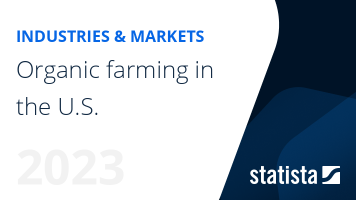Organic farming in Germany - statistics & facts
More organic hectarage
Organic farming hectarage in Germany has steadily increased in recent years, amounting to around 1.94 million hectares in 2023. For comparison, ten years earlier figures totaled around one million. When looking at acreage for individual types of crops, generally a positive trend is also visible. Organic vegetable acreage has mostly increased in the last decade, with around 18,100 hectares being used in 2023. However, Germany had a self-sufficiency rate of 36 percent in terms of vegetable supply as of 2022/2023, which means that imports are still necessary to cover domestic demand.For a green future
Organic products need to be officially certified to be sold as such. In 2023, the highest number of products certified was found among hot drinks, with over 16,300. Other top three contenders included herbs and spices, then bread and baked goods. Organic farming continues to be of long-term importance not only for the future of German agriculture. It is also part of a much wider framework for reaching other targets such as overall sustainable production, consumption and even the transition or renewable energy. Government aid for introducing organic cultivation methods was generally higher than aid for maintaining these methods, which provides a valuable incentive for businesses looking to expand their organic farming. In 2023, aid for starting organic farming of permanent crops or nursery stock amounted to 1,210 euros per hectare. This was the highest amount of aid provided in terms of farming categories. Other eligible areas included grassland and vegetable cultivation.With agriculture playing a key role in supplying the largest population in the EU with produce and food, organic farming is of vital importance in the long run regarding the quality of food products in Germany. Additionally, following organic farming practices contributes to protecting the environment that the sector relies on to exist.



















































